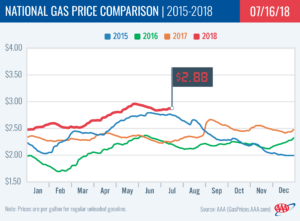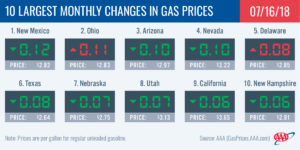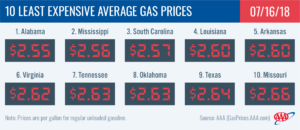Since July 4, gas prices have increased three cents, putting today’s national average at $2.88. Since last Monday, the average is just a penny more expensive nationally while some states are seeing nearly a dime jump, including Delaware, Florida and Michigan.
“Typically during July, gas prices have a tendency to trend cheaper. However with crude oil prices nearly $25 more a bbl compared to last year, we are seeing an upward pricing trend,” said Jeanette Casselano, AAA spokesperson. “If this trend continues, and if we see any supply disruptions, like a hurricane, pump prices may see new three-year highs.”
Today’s gas price average is just two-cents cheaper than last month, but 63-cents more expensive than at the same time last year.

Quick Stats
- The nation’s top 10 largest monthly changes are: New Mexico (-12 cents), Ohio (+11 cents), Arizona (-10 cents), Nevada (-10 cents), Delaware (+8 cents), Texas (-8 cents), Nebraska (-7 cents), Utah (-7 cents), California (-6 cents) and New Hampshire (-6 cents).
- The nation’s top 10 least expensive markets are: Alabama ($2.55), Mississippi ($2.56), South Carolina ($2.57), Louisiana ($2.60), Arkansas ($2.60), Virginia ($2.62), Tennessee ($2.63), Oklahoma ($2.63), Texas ($2.64) and Missouri ($2.66).

West Coast
Pump prices in the West Coast region remain among the most expensive in the country, including: Hawaii ($3.77), California ($3.65), Washington ($3.43), Alaska ($3.39), Oregon (3.31), Nevada ($3.22) and Arizona ($2.97). However, most prices in the region have declined on the week, with Arizona (-3 cents) and Nevada (-2 cents) leading the group, only Hawaii (+4 cents) saw an increase.
According to the Energy Information Administration’s (EIA) petroleum status report for the week ending on July 6, inventories of gasoline in the region grew by 300,000 bbl. They now sit at 30.8 million bbl, which is just over 2 million bbl higher than total levels at this time last year. The surplus will likely help guard against price spikes in the event that supply tightens in the region this week.
Great Lakes and Central
The states with the highest and lowest gas averages in the Great Lakes and Central region — Michigan ($2.99) and Missouri ($2.66) — saw some of the nation’s largest gas price jumps on the week at seven and five cents, respectively. Ohio (+6 cents), Indiana (+2 cents) and Kentucky (+2 cents) join Michigan and Missouri on the top 10 list with the largest increases this week. Iowa (-1 cent) and North Dakota (-1 cent) were the only states in the region to see prices drop, while Illinois ($2.95) held steady. Meanwhile, Michigan and Illinois are inching closer to the $3/gallon or more mark. Nebraska (-7 cents) has the largest decrease in gas prices of all states in the region compared to June.
Despite the pump price jumps for a handful of states on the week, gasoline inventories dropped by just a nearly 540,000 bbl. Total inventories remain above 53 million bbl, according to the EIA, which is where levels sat this time last year and are higher than July’s prior to 2017.
South and Southeast
Most South and Southeast states’ gas price averages are more expensive on the week. Florida (+8 cents) and South Carolina (+4 cents) have the largest increases in gas price averages in the region and are among the top 10 states with price increases. Conversely, New Mexico (-2 cents) ranks as the number two state in the country with the largest decline.
This week, Alabama ($2.55) claims the cheapest gas price average in the country, pushing South Carolina ($2.57) out of the top spot to the third cheapest.
For a third week, inventories drew down in the South and Southeast region by nearly 1.1 million bbl. At 81.5 million bbl, total stocks sit at one of the lowest points this summer for the region, but are 650,000 bbl ahead of this time last year, according to EIA data.

Mid-Atlantic and Northeast
Gas prices are as much as eight cents more expensive on the week for Mid-Atlantic and Northeast states, while a handful of states saw prices decline by a penny, including: Rhode Island, Connecticut, New York and Massachusetts. Four states saw prices hold steady: West Virginia ($2.85), Maine ($2.85), New Hampshire ($2.81) and Vermont ($2.92).
Delaware ($2.85) continues to see its gas price average jump week-over-week and has the largest increase of any state in the region and country this week. Today’s average is eight cents more on the week and 16-cents more than on July 1.
Motorists in four states in the region are paying $3 or more to fill up: Connecticut ($3.08), Pennsylvania ($3.05), Washington, D.C. ($3.03) and New York ($3.01)
With the addition of 961,000 bbl of gasoline inventories, the Mid-Atlantic and Northeast region saw the largest build of any region in the country, which likely helped to stabilize prices for most states. The large increase could help to stabilize prices in the coming week, especially if the region sees another build in inventory.
Rockies
Gas prices in Idaho ($3.14), Utah ($3.13), Wyoming ($2.96) and Colorado ($2.84) are a penny cheaper than last Monday. Montana’s gas price average increased a penny to $2.94 on the week.
Idaho and Utah have the most expensive gas price averages in the region and rank as the country’s seventh and eight most expensive states.
For the first time in a month, gasoline inventories in the Rockies region declined yet continue to measure above the 7 million bbl mark. In fact, year-over-year, inventories are up 422,000 bbl.
Oil market dynamics
At the close of Friday’s formal trading session on the NYMEX, WTI increased 68 cents to settle at $71.01. Concerns surrounding tightening U.S. supplies are slightly elevated following EIA’s news that total crude oil stocks recorded the largest decline (12.7 million bbl) since October 2016. Oil prices may continue riding high and contribute to increased pump prices throughout the summer and possibly into the fall, especially if demand remains robust amid high export levels.
The U.S. oil rig count remains unchanged from the previous week, according to Baker Hughes, Inc., keeping the total number of rigs to 863. When compared to last year’s count at this time, there are 98 more rigs.
Motorists can find current gas prices along their route with the free AAA Mobile app for iPhone, iPad and Android. The app can also be used to map a route, find discounts, book a hotel and access AAA roadside assistance. Learn more at AAA.com/mobile.
